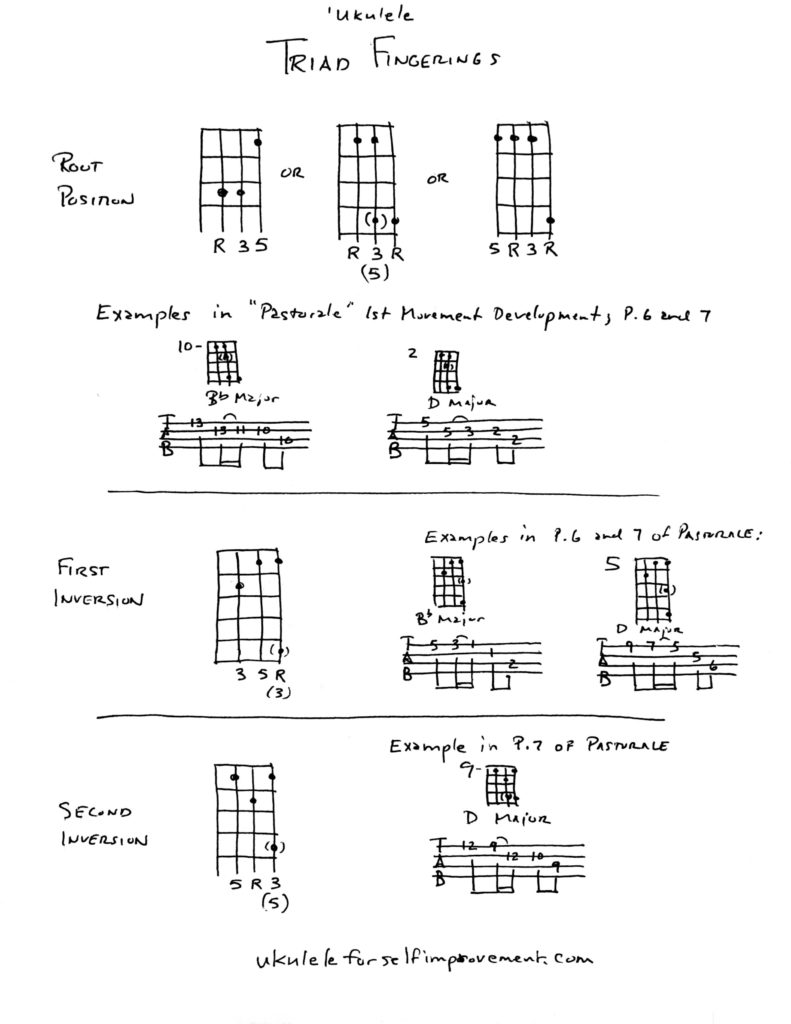In Episode 7 of Beethoven of the ‘Ukulele, I start to play the development section of the Pastorale’s first movement. This is where the composer starts to “develop”, or play around with, elements that were introduced in the opening of the movement. Beethoven kicks off the development of this movement by taking the “1 &a 2 &” rhythm first found in the second measure and repeating it over and over, applying it to arpeggios of triads in different inversions….
Here’s a chart I put together to go with Episode 7 that diagrams some of the most important triad inversions on the ‘Ukulele and gives examples of where they are found in pages 6 and 7 of the Pastorale Symphony. Click on the photo for a .pdf of your very own that you can print if you want 🙂

Triad. Arpeggio. Inversion. For those of you who “seized up” when you saw those words, I don’t want you to get scared. I’ll give you a quick explanation of the terms triad, inversion and arpeggio right now. If you’d like to know more, please get in touch because I’d love to explain more about them in future posts.
For most musical styles you’re probably familiar with, a triad can be thought of as the basic chord, or building block, of harmony. It is a structure that contains three different notes, a root, which gives a triad its name (e.g., a “D major triad” or a “B-flat major triad”), a third and a fifth. In the diagrams above these are designated by the letter “R” and the numbers 3 and 5. There are four different kinds of triads, but Beethoven uses only one type in the first part of the development, the major triad, which is probably the most commonly heard chord in Western music.
An inversion of a chord can be thought of as the way the different notes of the chord are arranged in relation to each other. If the root is the lowest pitch heard, the triad is said to be in “root position”. If the third is the lowest pitch, the triad is in “first inversion”. If the fifth is the lowest pitch, the triad is in “second inversion”.
An arpeggio is simply playing the notes in a chord in succession, one after the other, rather than all simultaneously.
I explain this in a lot more detail after I present page 7 of the Pastorale score in my latest video.
All of this stuff is part of what’s collectively known as music theory, and it’s essentially the study of what makes music work–the “grammar”, if you will, of music.
“It has a melody both happy and sad, build on victorious young triads”-CAKE, “Commsioning a Symphony in C”
These lyrics came to mind when preparing this post. Some of you might remember CAKE, an alt-rock band that hit it big around the turn of the century with “Short Skirt/Long Jacket”. “Commisioning a Symphony in C” came off the same album. I’m pretty sure they were talking about Haydn in the song, and Beethoven’s Pastorale Symphony is in F, not C. At any rate, here’s CAKE’s song if you’re interested. The song transports me back to graduate school, which seems like a lifetime ago. It really doesn’t have much to do with what I’m talking about here, it’s just one of those random associations:
As of this writing (July 15, 2019) 83 people have joined me on this journey, which means we’re that much closer to the audacious goal of making Beethoven’s Pastorale Symphony available to anyone in the world who wants to play it on the ‘Ukulele! If you’ve signed up for the newsletter, I want to tell you how much I appreciate it, especially those you who have taken time to send me an email or leave a comment on the YouTube videos. If you haven’t yet, what are you waiting for?
all the best to you!
-James
Comments are closed.